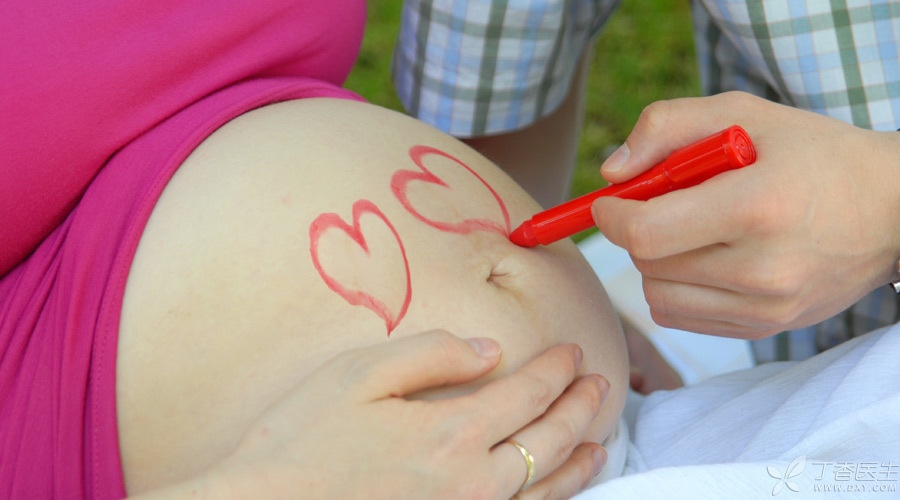
Do a B-ultrasound and find out that you are pregnant with twins?
The surprise is not difficult to understand, if accompanied by some [shock], in fact, it is not surprising-the vast majority of pregnant mothers who are pregnant with twins will really be at a loss at the beginning.
Many people think that having two or more babies at once is a wonderful event, but in fact, it means that the pregnant mother will bear greater risks and heavier physical burden throughout the pregnancy. Be prepared psychologically, and the next day may not be as satisfactory as imagined.
Next, let’s take a look at in a relatively easy way what aspects the pregnant mother who is pregnant with twins needs extra attention during the next pregnancy.
1. Pregnancy between 30 and 40 years old is more likely to give birth to twins.
We often hear that [the older you get, the harder it is to conceive], which is true, but for twin pregnancies, late pregnancies will increase its incidence.
This is because twins can be regarded as [abnormal reproduction phenomenon] to some extent, which can only occur when the embryo develops abnormally or two eggs are laid at a time.
However, as women grow older, the occurrence of irregular ovulation cycle will increase compared with the previous one, thus the possibility of laying two eggs at the same time will obviously increase, and the occurrence of twin pregnancy will also increase.

2. Need to eat more folic acid-more than 2 times!
In order to ensure the nutrition needed for the development of the nervous system of the two fetuses, the pregnant mother who is pregnant with twins needs to supplement more folic acid during pregnancy.
So, how much should we eat? If you eat 400 micrograms a day when you are pregnant with only one, is it good to double it when you are pregnant with two?
No, doctors suggest that pregnant women with twin pregnancies should take 1,000 micrograms (or 1 milligram) of folic acid every day.
If you don’t take folic acid well, what about how? If the pregnant mother lacks folic acid, the proportion of fetal [neural tube malformation]-such as [spina bifida]-will increase.
3. The prenatal examination is more frequent and requires frequent B-ultrasound.
More than one pregnant mother complained to the director of the hospital that it took a whole day to go to the hospital for a prenatal examination, which felt like a long march. In particular, the more inconvenient it is to go to the back, the more frequent it is.
Since the risk of having two is significantly higher than having only one, doctors need to check the health of the fetus and pregnant women more frequently.
Usually, pregnant mothers only need two ultrasound examinations of [large abnormalities] [developmental status], but twin pregnant mothers need to undergo B-ultrasound examinations from time to time throughout pregnancy to ensure the health of both babies.
Especially in the first trimester of pregnancy, the first ultrasound report is very important. Pregnant mothers should remember to bring it with them when reviewing it later.
If necessary, pregnant mothers also need to undergo invasive examinations such as amniocentesis. Originally, amniocentesis had the risk of causing abortion. As twin pregnancies may need to be punctured twice, the risk of abortion doubled.

4. Endure more severe physical discomfort…
Elevated levels of hCG are the main cause of pregnancy vomiting. If pregnant mothers are pregnant with two, the blood hCG level will increase more obviously, thus twin pregnant mothers are more likely to vomit during pregnancy and vomit more violently in the first trimester of pregnancy.
However, there is no need to worry too much. Under normal circumstances, like most pregnant mothers, the symptoms of pregnancy vomiting of twin pregnant mothers will come to an end in about 12-14 weeks.
More violent, of course, is not only pregnancy vomiting.
Twin pregnant mothers are more likely to suffer from back pain, poor sleep, gastric acid regurgitation and heartburn than most pregnant mothers. In addition, twin pregnant mothers are more likely to suffer from anemia and postpartum hemorrhage.
Wipe one hand, are bitter tears.
5. Vaginal bleeding is more common, don’t panic
In early pregnancy, vaginal bleeding may be a normal phenomenon, but it may also be a sign of miscarriage. Mothers with twins and multiple births are significantly more likely to suffer vaginal bleeding in early pregnancy than mothers with single births, because, first of all, they are more likely to miscarry than mothers with single births.
However, the pregnant mother should not be too nervous when she finds vaginal bleeding. In many cases, no matter how many births she is pregnant with, painless vaginal bleeding has nothing to do with abortion.
Only when there is continuous vaginal bleeding, and the amount is large and contains blood clots, the possibility of abortion is relatively high. At this time, you need to see a doctor immediately.
6. Fetal movement will not appear in advance, don’t worry
No matter whether you are pregnant with singletons or twins, fetal movements will occur at 18-20 weeks of pregnancy.
Similarly, pregnant mothers who have already given birth to one child feel the fetal movement earlier, because they already know the feeling of fetal movement and will not confuse fetal movement with gastrointestinal peristalsis like novice pregnant mothers.

7. If you are pregnant with two, you will get fatter during pregnancy.
Twin pregnant mothers have two fetuses, two placentas and more amniotic fluid in their stomachs, and their stomachs will be significantly larger than those of single pregnant mothers in the same month.
At this time, the pregnant mother needs to provide sufficient nutrition for the two fetuses, and naturally she should eat more. As a result, if she is not careful, the pregnant mother will never return on the way to gain weight…
It is generally recommended that the weight gain during twin pregnancy is about 13-16kg, not more than 18kg at most, while the weight gain during single pregnancy is about 11kg.
The American Medical Association’s current guidelines for weight gain for twin pregnancies throughout the pregnancy are:
- Normal weight pregnant women (BMI 18.5 ~ 24.9): weight gain 14 ~ 23 kg Overweight and obese pregnant women (BMI > 25): weight gain 11 ~ 19 kg
As the specific situation of each pregnant woman is different, pregnant mothers had better communicate with doctors to determine the weight gain that is most suitable for them.
8. Be especially careful of gestational diabetes!
Mothers with twins are more likely to develop gestational diabetes than mothers with singletons.
The greatest harm of gestational diabetes mellitus may be that it will lead to macrosomia and increase the probability of cesarean section.
Fortunately, the death rate of the baby in the belly of the pregnant mother of twins will not increase, because under normal circumstances, twins do not grow very big.
No matter whether they are pregnant with singletons or twins, pregnant mothers who have suffered from gestational diabetes are more likely to suffer from type 2 diabetes than ordinary people even if their blood sugar returns to normal after delivery.
9. Be especially alert to preeclampsia!
Although we are still unable to determine whether the cause of preeclampsia is what, clinical data show that twin pregnant mothers are more likely to suffer from preeclampsia.
Symptoms of preeclampsia include hypertension, proteinuria and sometimes limb edema. If the pregnant mother’s condition is not well controlled, it may lead to severe eclampsia of the fetus. If serious, it may even endanger the baby’s life.
10. Prepare bags to be delivered in advance and beware of premature delivery.
More than half of the mothers of single births will give birth to their babies at about 40 weeks of pregnancy, while for twin mothers, the time is about 36-37 weeks.
In general, if twins are born after 34 weeks, their physical condition will be better, but they are always premature and generally have two problems:
-
Weight is lighter, less than 5 kg is more likely to get sick;
-
Respiratory system hypoplasia is prone to [neonatal respiratory distress].
Unfortunately, at present, there is still no better method to prevent the occurrence of premature delivery clinically, and there is no significant effect on continuous bed rest or drug use.

11. It is not necessary to do so, but it is likely to be necessary
Compared with single births, from a statistical point of view, twin mothers are more likely to give birth by cesarean section.
This is mainly because, the baby in the belly of the twin pregnant mother, the incidence rate of buttocks facing down is relatively high. At this time of natural labor, the risk is greater, while cesarean section is safer.
If the head below the twins is rushed down, the pregnant mother can try to give birth smoothly.
